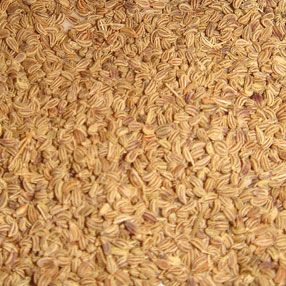

Ajwain

Ajwain was first cultivated for extract, whose principal component, thymol, has bactericidal and antiseptic properties. Ajwain comes from southern India and in the old Orient, its seeds were used as a natural antiseptic and anti-flatulence agent. Lentils are an appropriate legume to cook with ajwain. The main supplier of ajwain is India, but it is also grown in Afghanistan, Pakistan, Iran and Egypt. Ajwain is an excellent additive to foods high in starch. In Southeast Asia it is routinely added to bread and unsweetened pastry. Ajwain may be replaced by thyme, but in a much smaller quantity, since ajwain’s flavor is much stronger.
Ajwain has a taste and smell strongly similar to thyme, with a slight sharp and bitter aftertaste, It seeds have a 30% fat content, It is an ingredient in spicy Indian nut and legume mixes, bread dough and is often an ingredient in curry,It is cultivated not only as a spice, but also for thymol extract, which has bactericidal and antiseptic properties?
It is the primary ingredient in the Ethiopian spice mix “Berbera”, together with cloves, fenugreek, pepper, ginger, coriander and cardamom.
It is added to legumes primarily to reduce flatulence, which most legumes cause, ajwain as a spice consists of dried seeds, whole or ground, of the plant Trachyspermum ammi.
History
Trachyspermum ammi originated in the Middle East, possibly in Egypt, and the Indian subcontinent, but also in Iran and Afghanistan. It is sometimes used as an ingredient in berbere, a spice mixture favored in Eritrea and Ethiopia.
In India, the major producers are the states Rajasthan and Gujarat, with Rajasthan producing about 90% of India’s total output.
